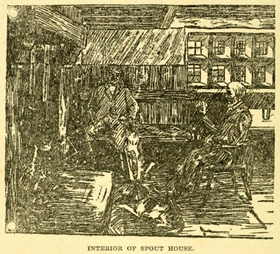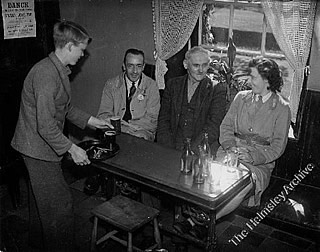Spout House & Sun Inn
This page is dedicated to the memory of William and Madge Ainsley of the Sun Inn.
Alyson Jackson
Images and information content subject to copyright
- please do not use or reproduce anything from this website without permission, (which isn't usually a problem), acknowledgement and link - email for more information.
Website
created and updated by Alyson Jackson (launched 2002).
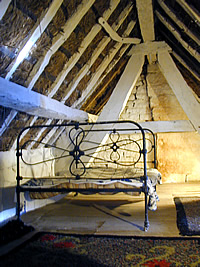
The upper room at the east end of Spout House showing the A-shaped cruck frame.
Though "Life and Tradition in the Moorlands of North-East Yorkshire"1 has the date of the building of Spout House as 1606, every other source I've seen has it as 1550. However, "Life and Tradition..." is very good on the type of house that it was - a typical cruck-built farmhouse, that is the frame was formed from timbers creating an 'A' shape. It had three bays and two pairs of crucks. All local materials would be used - stone for the walls and thatch for the roof.
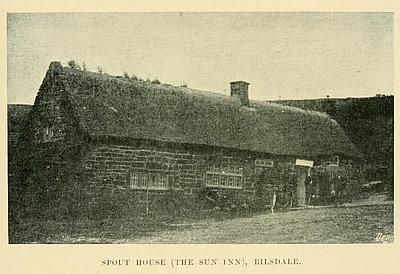
Spout House (The Sun Inn), early 1900s - possibly earlier, from "England's Oldest Hunt".2 The building faces south.
A farm household such as lived at Spout House would have been almost entirely self-sufficient in food. Even if it was a sheep farm they would have kept at least a cow or two, some chickens, perhaps bees and a pig for the home which was fed on scraps and slaughtered for food, grown potatoes, vegetables and some wheat or corn to be ground at the local mill for flour.
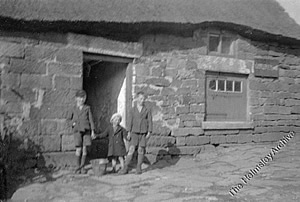
"Doris Tomlinson with two Ainsley boys"
By kind permission of the Helmsley Archive
This photograph clearly shows the wooden and glass "window" on the ground floor - the room behind may have been used for animals in the building's early days. The inner wall of the cross passage is clearly very rough.
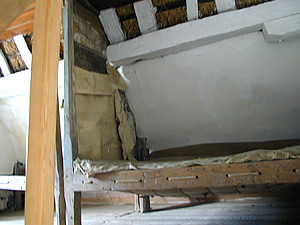
Early seventeenth century box beds with a rope base on the upper floor of the old inn; such beds were certainly in use in the sixteenth century. Rope was threaded through the frame across and from top to bottom, tightened to form a taut net on which a mattress of some description could be supported.
Downstairs the house was divided by a cross-passage leading from what is now the front door. A ladder led up to the bedrooms - one on the right, two on the left but all connected - there was no corridor. On the ground floor the room on the right may originally have been for animals. Early photographs show that the large window to this room is, in fact, mainly wooden.
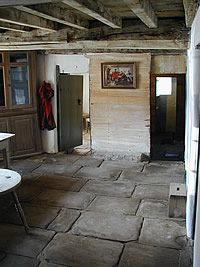
The large main room of the old Sun Inn.
On the left of the cross-passage was a large kitchen/bar parlour with a fireplace and brick oven to the side where cooking could be done on an open fire, usually of turf, and where meals were eaten. A range was installed much later, probably in the nineteenth century. The floor, perhaps originally just beaten earth, was laid with heavy flagstones and clip rugs would have been used to provide some warmth and decorative effect. Through the kitchen was a low parlour, which could also have been used as a bedroom.
From here a stair led up to the bedrooms. In the early seventeenth century the first two each had a pair of box beds1 - this is where guests would have slept when the building became an inn as well as a farmhouse. Windows up here are at floor level and there would have been little furniture apart from the very basic beds and perhaps boxes for keeping things in. The children would certainly have slept more than one to a bed when space was at a premium.
The Bilsdale Surveys 1637-18513 are a useful source for the early times of Spout House when it was a working farm.
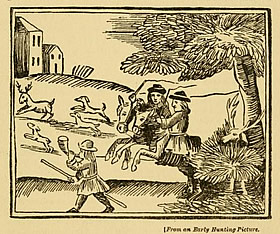
The stag hunt - much older than fox-hunting; stag hunting was abandoned in 1750 but in 1821 the Hunt came upon a stray stag which became the quarry of the last ever stag hunt in Bilsdale;from "England's Oldest Hunt" 2
In 1637 a survey was carried out on the Helmsley estates of George Manners, 7th Earl of Rutland, which included Spout House. He died in 1641 and in 1642 there was a second survey, this time for Lord Francis Villiers who was only twelve years old at the time. His mother was Lady Katherine Manners, Baroness de Ros of Helmsley, and she had probably marked the Helmsley estates for her younger son, Francis, though the elder son, George, 2nd Duke of Buckingham, would actually inherit these and the title of Baron de Ros on the death of his mother in 1649 as Francis had been killed during the Second Civil War in 1648.
The second duke "retired" to Helmsley Castle in 1670. A keen fox-hunter at his other estates, he may well have already kept hounds in Yorkshire3. It is said that the duke kept two packs of hounds - one for stag and the other for fox hunting. At this time the fox was regarded as vermin and in no way a noble beast such as the stag or hare. The duke was a renowned horseman and the Bilsdale men took to hunting with zeal.2
The duke was regarded with great affection in Bilsdale, being very friendly and open with the people there, despite his rather licentious reputation at court. When hunting he stayed at one of his tenant's (Atkinson) homes, Bumper Castle, where, it is said, many a convivial evening was spent after a day's hunting. He kept a cellar there and told his host that if "owt happened to him" he had to have his erstwhile sporting friends in and "drink t' lot dry"2 .
The Bilsdale Surveys of farming property and land are a good starting point to see what is happening to Spout House in the seventeenth century. Charles I had been king since 1625 but the First Civil War, which raged from 1642 to 1645, would soon split the country. George, 1st Duke of Buckingham, was a great favourite of the king and on his death the two sons were brought up at court.
In the 1637 survey one John Kirke holds
"at will one messuage called Spootehowse, one backhowse, one barne, one oxehowse, one cowhowse, one calfehowse, one kilne, one close called Smedye Holme meadowe containing one acre, Northfeild in three partes arable and meadowe containing 5 acres, Medlewood meadowe containing 3 acres, Burthwaite Holme, meadow and arable containing 3 acres, Farfeild meadowe and pasture in 4 partes containing 7 acres, New Close meadowe containing one acre, Broade meadowe containing one acre, Wastland and 2 little garthes pasture containing 2 acres, High Broadefeild pasture containing 2 acres, Cow Close pasture containing 2 acres, Springe Hagg 2 acres: and paies at the said feasts yearly 36s. 2d."
In the 1642 survey John Kirk (sic) is still "tennaunt" at "Spoute House Farme" with over 77 acres.
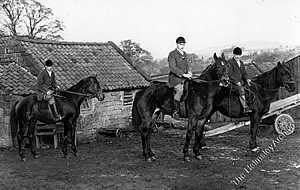
The huntsman, Edward Basil Ainsley (centre), and two whips of the Bilsdale Hunt (some time between 1953 and 1955).
By kind permission of the Helmsley Archive
In both surveys there is actually a second dwelling Spouthowse/Spout House Farm in Bilsdale. This may not be surprising as the "spout" is simply a natural spring and there would surely be more than one in Bilsdale with any nearby dwelling taking it for a name. The tenant of the second farm is John Carter. Inspection of the locations of the respective properties confirms that it is John Kirk who occupies "our" Spout House.
The next survey was not for over a hundred years. Eight years after the second duke died in 1687 Helmsley Estate was sold to pay off his creditors. The purchaser was banker Charles Duncombe, a commoner who made a vast fortune. It is around this time that the famous Bilsdale Hunt was independently established with hounds from the duke's kennels2 . Spout House was the Hunt headquarters for considerable periods4 and the association continued with the new Sun Inn. WIlliam Cyril Ainsley recalls that his grandfather, James Ainsley, who was born at Spout House in 1845, remembered as a boy that:4
when conditions were suitable for a hunt, the huntsman would blow his horn and the message would be passed up the dale and down the dale by other supporters, so that an hour or so later they would all be gathered together and ready to set off.
This anecdote is corroborated in "England's Oldest Hunt"2 :
...when the dalesfolk wanted hounds upon extraordinary days or in consequence of the knowledge of the whereabouts of a fox, such as were within the hearing of the horn were called up and away they went, minus scarlet and possibly without he who at this particular period was nominally huntsman.
In 1781 the estate belonged to Charles Slingsby Duncombe and it was he who commissioned the survey. Two residents are recorded: at Spout House a Francis Mason and the very next entry is Spouthouse with a Stephen Hoggard. While Mason has a number of fields assigned to him, the entry for Hoggard is completely blank - possibly indicating that his role was as landlord.
The 1781 survey has an associated map and now it is possible to see the route of the surveyor. The entries follow a geographical route, much in the way a modern census does. So the entries immediately around the Spout House entries go : Hollin Bower, Mire Ing, Spout House, Spouthouse, Helm House (2 entries), Lavrock Hall (2 entries) - these dwellings follow each other south westwards across the dale then turn south east. This fixes the location of Spout House as Kirk's farm and the eventual Ainsley home.
John Carter's place seems to be close to Hasty Bank or Hastiebancke Farme; indeed in his 1637 entry it states "His holme lying in 3 partes next unto Widdow Hugalls intack" - Widow Hugall occupied Hastiebancke Farme. Hasty Bank is far to the northern end of the dale.
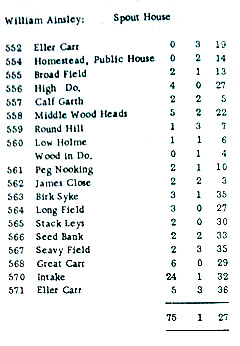
The entry for Spout House from the Bilsdale Survey of 1826. The numbers on the left refer to maps published in the survey.
It seems certain, then, that Spout House was occupied by Kirk in the mid-seventeenth century, but housed two families - Mason and Hoggard - in the late eighteenth century.
Spout House was first granted a licence to serve alcohol in 1714. The 1781 survey, however, makes no mention of a hostelry of any description, though it may just be that these are specifically surveys of farms, and as mentioned, it is possible that the lack of farming-related information for Stephen Hoggard may mean that he was holder of the licence. In both this and the later surveys of 1808 and 1826 it is still called Spout House.
Tenants from this time onward combined farming with innkeeping, farming taking precedence, certainly during the day.
A survey performed around 1808 and copied in 1814 has only one entry for "our" Spout House - the property near Hasty Bank is no longer listed. Stephen Hoggard is now in residence farming 75 acres, so it looks like Hoggard took over the farming from Mason (or his successors) and worked it alongside operating the inn.
In 1826 the entry for Spout House clearly includes the Public House and finally we have an Ainsley tenant: William Ainsley. As well as this he was also farming just over 75 acres of land. This was William Henry Ainsley, born in 1785 at High Crosset farm, who took over the inn in 1822 from Stephen Hoggard who had held the licence for 57 years4. He was also farming 75 acres - this would almost certainly have been mainly sheep and/or cattle. William was the first of a long line of William Ainsleys to run the Spout House and Sun Inn.
| William Henry Ainsley (1785-1895) m Amelia Hunton |
|||
| Siblings Jane, Hannah | Nanny (1828-) m Nicholas Spink | William (1829-1905) m Ruth Arcoat |
Siblings John, Mary, Stephen, Emma (Amelia), Sarah, Martha, Joseph, James, Elizabeth, Margaret, Emma |
| John | William (1865-1950) m Dorothy Ann Barr |
Annie | |
| Ruth Hannah | William Edward (1893-1953) m Margaret Eleanor Warriner |
John Arcoat, James, Margaret Edna | |
| William George (1929-2012) m Margery | Edward Basil, Martyn | ||
In the 1841 census 55 year old William was living at Spout House with his 30 year old wife Amelia (née Hunton - she was actually born 1807 so would have been around 34 at this time) and seven of their children: Hannah (14), William (12), Mary (8), Stephen (6), Amelia (4), Sarah (3) and Martha (1). Three children are missing from this list: Jane (16), Nanny (13) and John who had died aged four in 1836. Nanny can be found as Ann with her unmarried Uncle John at Low Crosset, listed as an agricultural labourer but more likely keeping house for him.
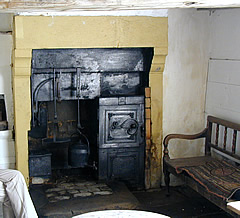
This was the cooking range in the nineteenth century - still an open fire on a hearth with a cauldron or kettle suspended above it; to the right an enclosed box for baking with a fire box below.
William is listed as a farmer, innkeeping is not mentioned, indicative of the relative importance of the two occupations, perhaps. Also at the address were two William Weatherills, both agricultural labourers, one aged 60 and the other 25. The elder Weatherill is listed in a separate entry - as in the 1781 Bilsdale Survey two families apparently at one address.
Ten years later fourteen members of William and Amelia's family are recorded at Spout House: William, a farmer of 75 acres with one labourer and Amelia his wife, children Jane (25), Hannah (24), William (21), Stephen (16), Amelia (14), Sarah (12), Joseph (7), James (6), Elizabeth (3), Margaret (1) and two grandchildren: Alice (3) and Henry (1). These last two were children of the eldest child Jane. Mary was in her grandparents Hunton household in Fangdale Beck - whether as a visitor or actually living there is not known.
As if this weren't enough, the Weatherill family is also still there, comprising William (35) a Dry Waller and his wife Elizabeth (30), their children Mary Ann (Davison, 12), Margaret (7), John (5), William (3) and Thomas (10 months) and Uncle William Weatherill aged 72. In total that is 22 people at Spout House - it's impossible to imagine how the building could accommodate this number of people!
However, as we shall see, there were almost certainly two homesteads at the location, which is called Spout House: the old Sun Inn and a building next to it.
"Life and Traditions.."1 devotes a chapter to stone masons. The Weatherill family continued right up until at least the 1970s to be stone masons. William Weatherill (1777-1866) "...in 1810 settled at Spout House, a seventeenth century house next to the old Sun Inn in Bilsdale. The two acres which went with it and on which they kept a cow and a few hens, 'was hardly enough' say their descendants."1 This home "next to the old Sun Inn" is obviously a separate building. It is probable, then, that the location is identified as Spout House and comprises at least two homes.
In 2017 I unexpectedly received comfirmation that there were, indeed, two dwellings at Spout House. My correspondent was born in the northern of the two dwellings, not the old Sun Inn, and says that the two buildings were remarkably similar: "the same size, and with almost identical floor plans, both ground floor and loft, except that ours had no cellar" and goes on to say that their dwelling had the "Spout": "Just beyond the eastern end of the house was a stone spout, about knee high, in a wall. A small stream flowed from that into a stone-lined "box" lowered so it's top was at ground level. The water then ran from the bottom of that, and disappeared under the house - which is set at the very lowest level of a small valley."
The early decades of the nineteenth century were a time of relative prosperity. Almost everything was local. Markets for sheep and cattle were no further than Stokesley or Helmsley and there was even a sheep market annually at Spout House5. Potatoes, vegetables, corn would all be grown for home consumption and also for the animals. A contact at the Yorkshire Farming Museum provided this insight:
Regarding the feeding of livestock - traditionally a sheep farmer (especially on a smaller farm) would have grown root vegetables to feed the livestock. Turnip was a particular favourite. However to save the labour intensive costs of harvesting, often the farmer would plant the root crop then block it off from the flock with 'hurdles' (like temporary gates). The sheep would be allowed access to some of the field to eat the crop (they would eat both the leaf and the root beneath it) then after an allotted time, the farmer could move the hurdles back and let the sheep have a little more of the crop to eat and so on until the particular patch was cleared of crop. The sheep effectively harvest the field themselves, and leave a freshly manured soil bed behind them into which the farmer can re-plant the turnip crop.
It sounds very efficient!
In 1861 there are still two families at Spout House. Sadly Amelia had died in 1852 and WIlliam, now farming 70 acres, is with his sons William and Joseph, daughters Martha and Emma, and grandchildren Alice and Henry.
The Weatherill household has expanded further! William is now a quarry man and at the census his wife Elizabeth, daughters Margaret, Esther and Elizabeth, sons John, Thomas and Davison, Uncle William - still going at 82! - and cousin Francis, also a quarry man, are at the address. The four sons - John, William, Thomas and Davison all followed their father to become stone masons or quarrymen1 . In 1869 William and his son Thomas supplied the stone for the monument to the second Baron Feversham by Sir Giles Gilbert Scott which stands in Helmsley market place. The block was 7 feet square (about 2 metres square) and weighed around 7 tons (around 7,000kgs), cut from a tumbler near Spout House - a tumbler is a boulder weighing up to 300 tons which had literally tumbled down from the moor1 .
Walling and quarrying were winter work. Walling was not particularly lucrative: Jack Weatherill recalled1 "a few shillings a week and a bit o' dinner affair, when there were nowt else ti git".
In 1871 Spout House had been handed to William's son-in-law, Nicholas Spink, who had married Nanny in 1851 - married in scarlet as befits a hunting man.2 He is now farmer of the 75 acres plus the Public House. William (Henry) had "retired" to Low Crosset though still, apparently, a farmer of 75 acres. His eldest son, also William, had married Ruth Arcoat in 1861 and they were living with their two children at Mounts further up the dale and farming 20 acres.
Not only is the Weatherill family still also at Spout House - William, Elizabeth, Thomas and Davison - but no less than five lodgers, all cloggers from Lancashire, are there.
Nicholas Spink was an avid fox-hunter and Master and huntsman of the Bilsdale Hunt from 1870 to 1886, and then jointly with Robert Garbutt until 1887, with the famous Bobby Dawson as his whipper-in. The Master is the person responsible for arranging hunting days and managing the hunt while the huntsman hunts the hounds on hunting days and might also look after the hounds on a day to day basis unless there is a separate “kennel huntsman” or “kennelman”. The roles of Master and huntsman could be combined, as in Nicholas' case.
Bobby Dawson's mother was great-grand-daughter of Robert Foster, huntsman of the second duke's foxhounds5. When Bobby Dawson died Nicholas became the oldest member of the Bilsdale Hunt. Stephen Ainsley, his brother-in-law (and my great-grandfather), was also a hunt member and present at Bobby Dawson's funeral2 .
It must be remembered that at this time foxes were regarded as little more than vermin but it seems there were, even in the late nineteenth century, people vehemently opposed to fox-hunting. Their form of protest was to lay poison for the hounds. A number died and Bobby Dawson wrote a note to J. Fairfax Blakeborough, author of "England's Oldest Hunt"2 asking that it be published:
BILSDALE HOUNDS
Who met at Buck Inn, Chopgate, on Tuesday, November 26th, at 10-30. A fair lot of horsemen were there, and about 40 on foot; through being a foggy morning was delayed until 11-30, then left Chopgate and went up the Green through the Bilsdale Hall to horro (Orra) planting, where the hounds threw off. They got on a drag and were soon away at a rattling speed, they running strait for Middle Head Crag, where foxes are very often run to ground after a few minutes' spin. Someone had a spite against hunting, were trying to destroyed [sic] the hounds by laying poison. One of the leading hounds got it, and died on the spot, about one mile from Chopgate. After a bit of delay Bobby Dawson was there, he swore it was the best dog in the pack. Bobby says 'it is our best plan to gether up the hounds and gan away yam or we lowse every dog in the pack.' This dog was kept by Mr. Ainsley, Sun Inn, Bilsdale, who is noted for keeping the best dog in the pack. £5 reward.
It seems that this was in 1872 so I'm not sure which Ainsley this would be as in 1871 and 1881 Stephen was farming Cow Helm. In 1871 Nicholas Spink was at the Sun Inn. Stephen's younger brother James, also a hunting man, was with their father at Low Crosset farm and their elder brother William was at Mounts.
Dawson was a strange character. Apparently he starved his hounds, his horses and himself, seems not to have been interested in the actual chase but loved to see the hounds work - and he could not bear to kill a fox!2
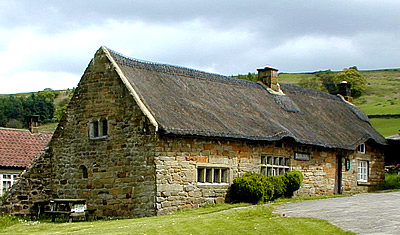
Spout House, 2007.
It is around this time that Spout House Cricket Team came into existence.5 The wicket is a flat strip of land scraped into a severely sloping field near the new Sun Inn. The Ainsleys have been very much involved with the club throughout its history. W C Ainsley tells how William (1865-1950), second son of William and Ruth, was secretary of Spout House Cricket Club for 72 years, from the age of 11 or 12 until he was 844.
Whatever the reason for them leaving Spout House, William and Ruth had returned by 1881 - presumably at the latest 1876/77 when young William was the cricket club secretary. For the first time in the census the entry for the Ainsley family is for "Spout house Sun Inn" Sun Inn is underlined emphasising that it is William who is landlord, though again still also farming 75 acres. The household is much reduced with only themselves, their two children William and Annie and a servant girl.
However, the Weatherill family is still in residence, their entry labelled Spout House only: William and Elizabeth, two daughters and a one son - the Weatherill men still quarrying stone. There is also a lodger as a separate entry for Spout House - a clogger from Scotland. The wearing of clogs, surely the most uncomfortable of footwear, was common up until about the time of the First World War.1
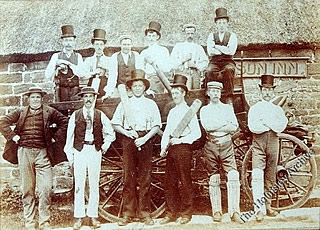
Spout House Cricket Team 1896
Back l to r: I. Peacock, Tom Garbutt, W. Ainsley, Ned Atkinson, Jack Wilson, Alan Garbutt
Front l to r: George Wood, John Dale, John Wood, I. Garbutt, Tom Hunton, Tim Hart
By kind permission of the Helmsley Archive
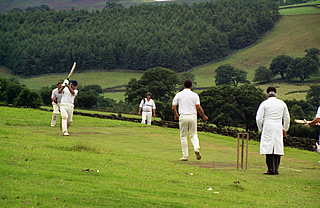
The sloping cricket pitch at Spout House, 1994.
In 1891 three separate households are listed for Spout House: William Ainsley, farmer and innkeeper, with his wife Ruth and daughter Annie with her husband William Garbutt; William and Elizabeth Weatherill with a lodger - both men quarrymen; and a new family Levi Knaggs, a labourer, and his wife Jane.
The cricket team is going strong and a wonderful photograph from 1896, courtesy of the Helmsley Archive, includes William Ainsley. The Weatherill family were also involved - they made the huge stone roller.
In the latter half of the century times became harder, the Yorkshire Farming Museum explains:
The late nineteenth century was a difficult period for British farmers, due largely to the burgeoning world market. For example the development of the railways across the continent allowed for easy transport of surplus corn to the British East coast. By 1866 following the end of the American Civil war, trade with America was on the increase too. In 1880 the first successful shipment of frozen meat arrived in Britain from Australia. All these factors started to have a detrimental impact on British farmers and devalued their own produce significantly. A quarter of wheat in 1882 would have fetched 45 shillings, by 1889 it was down to 30 shillings and by 1894 the same quantity would only fetch 24 shillings. (A quarter is equal to eight bushels, or approximately one-quarter of a ton).
In 1875 wheat was grown on 3,000,000 acres in Britain, by 1895 it was only grown on 1,500,000 acres; half the coverage of twenty years earlier. Ironically, many farmers adopted the use of machinery at this time as it was seen as a long-term cost saving measure; reducing the need to pay numerous labourers.
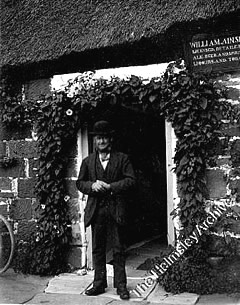
William Ainsley, father of William Edward, grandfather of William George
By kind permission of the Helmsley Archive
Blakeborough specifically mentions a hunt gathering at "Spout House Inn when all the old characters were assembled" around the end of the nineteenth century.2
In 1901 the Weatherill and Ainsley families remain at Spout House. Now it is Davison who is the head of the Weatherills, a stonemason. William Ainsley, now 70, is still farmer and Innkeeper, though interestingly Ruth is listed as a Publican - no doubt running the pub while William was working the farm. Altogether there are fourteen people listed, including a domestic servant attached to the Ainsley household.
Their son, William (far too many Williams!) had married Dorothy Ann Barr in 1890 and he is helping on the farm, his wife and three children Ruth Hannah (10), William Edward (7) and George (3) are there too. As well as helping his father on the farm, and later taking it over along with the inn, William was Secretary of Spout House Cricket Club for 72 years.4
In 1911 the Weatherills and Ainsleys are still in residence, the families of Davison and William. In the summary sheet while William is listed as occupying a Public House, Davison's dwelling is a Private House - more evidence that there were two dwellings.
Davison is with his wife Jane, four children: Tom (28), Mary Elizabeth (25), Arthur (15) and Lancelot (9), and a niece Frances Parker (7). He remains a stonemason, his son Tom a Quarryman. It is noted that they actually have six children.
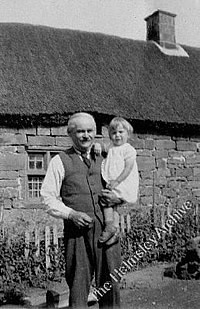
William George in the arms of his grandfather William
William, farmer and innkeeper, and his wife Dorothy Ann are living with their five children: Ruth Hannah (20), William Edward (17), John Arcoat (13), James (5) and Margaret Edna (7 months). Margaret Edna was to be the last child born at Spout House.
Perhaps the decline in profitability of farming, coupled with increased mobility of travellers and improving custom for the public house, persuaded the family to have the new Sun Inn built just across the yard. In 1914 it was completed. The original house was left much as it was as the family moved over to their new home - it must have been an amazing improvement for them. The old Sun Inn was closed up and left with all its furnishings inside, used only as a store.
William Edward married Margaret Eleanor Warriner and they had three sons William George, born 1929, Edward Basil, born 1930, and Martyn, born 1935 and died very young in 1961.
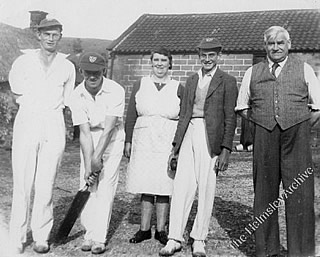
William Edward Ainsley with his wife Margaret and their three sons.
By kind permission of the Helmsley Archive
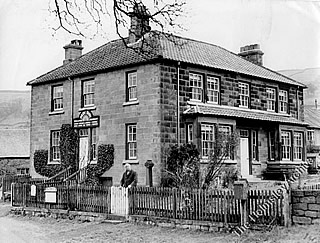
William Edward Ainsley (1893-1953) at the new Sun Inn
By kind permission of the Helmsley Archive
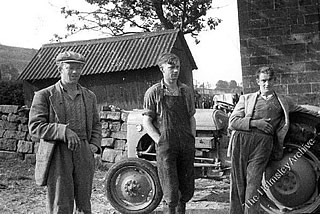
Three Ainsley brothers: William George, Edward Basil and Martyn
By kind permission of the Helmsley Archive
William Edward Ainsley was huntsman 1930-1953 followed by his son Edward Basil, 1953-1955.5 When William Edward took over, the kennels were moved to Spout House but after his tenure they were moved to Raisdale.4
William George eventually took over the licence of the Sun Inn and married Margery, always known as Madge. They had two children: Margaret Christine, who lives in Scarborough and works as a civil servant in York, and William Martyn George who still lives and works at Spout House Farm.
William and Madge were a delightful couple, always friendly and William loved to talk about the family and cricket.
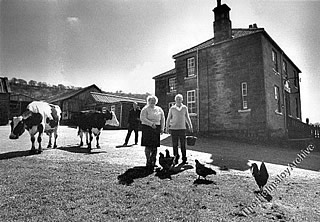
William and Madge, with their son behind,at the new Sun Inn
By kind permission of the Helmsley Archive
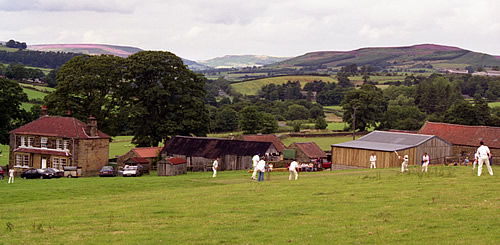
Cricket at Spout House, 1994
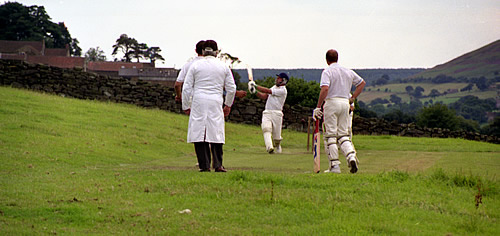
He had a fund of stories including anecdotes about one or two rather famous people. That most well-known of cricketers W.G.Grace was bowled out for a golden duck - in other words he was out on the very first ball bowled to him, undone by a hefty village blacksmith. And can you imagine Prince Harry in this most unassuming of bars - apparently he played in the Toffs vs Locals match one year6.
William George was secretary of the Spout House Cricket Club for 66 years. Anyone who has even a modicum of interest in cricket should make the effort to see a game at Spout House. There is no pitch like it anywhere in the world, it is great fun. It exemplifies what cricket - any sport really - is all about: enjoyment, competition and friendship.
It was William who first showed me the Family Tree created by William Cyril Ainsley and thus helped enormously in my own research.
I contacted William Cyril Ainsley who was most generous in sharing the amazing amount of research that he had done on the Ainsley family. He later sent the text from a postcard which William, father of Wm Edward, had sent to William Cyril's father, yet another William, on 9th April 1947, which is very illuminating about life in the dale:
Dear Cousin
I am writing to ask how you are getting on as I had a letter from Joe from Kirbymoorside and he had not heard anything since Christmas. I am sorry to say I have been very bad for about 9 weeks but am out again and improving. But the weather is so bad it is a real snow-storm here, and all is covered with snow but there is old drifts yards deep, nearly all the land is to plow for to sow. There is hundreds of sheep been lost in this worst storm I can remember. W.Edward is in bed, and has to give up riding this season. Hoping you are all improving,
Yours truly,
William Ainsley, Senior
So no hunting for William Edward that year!

The Sun Inn changed very little in the century since it was first opened. No food served in the small, very utilitarian bar which had a very limited range on offer. But it was an authentic "local" - meant primarily for the villagers and farmers, visiting sportsmen, thirsty workers and not at all for tourists. It closed in April 2011, just a couple of years before both William and Madge died, but has recently reopened with new tenants. The old Spout House was taken over by the North York Moors National Park Authority, renovated using traditional materials and methods, and can now be visited.
So I finish this piece with two portraits: one of Madge which I took myself and is how I will always remember her, and one of William which leapt out from the pages of the Swiss International Air Lines magazine7 in a piece on walking the moors - imagine the surprise!
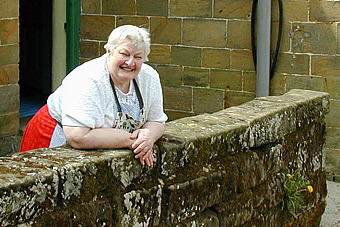

Swiss International Air Lines Magazine
References
- "Life and Tradition in the Moorlands of North-East Yorkshire", Marie Hartley and Joan Ingilby, Smith Settle, 1972.
- "England's Oldest Hunt",J. Fairfax Blakeborough, 1907; free online copy
- "Bilsdale Surveys, 1637-1851" edited and transcribed by M.Y. Ashcroft & Audrey M. Hill; North Yorkshire County Record Office Publication No. 23; January 1980. 4
- W.C. Ainsley research, also "An Old Bilsdale Family", Ryedale Historian, 1989
- "Bygone Bilsdale" Bilsdale Study Group, Roseberry Publications, 1992.
- Article in the Guardian, 2009
- "Enjoying the Elements" by Gero Günther, photographer Peter Neusser, Swiss International Air Lines Magazine, Issue 10, 2010
Last updated September 2013.
Thanks to Members of the Bilsdale Hunt for very helpful suggestions on sources.
Any images not otherwise attributed are the author's own.

